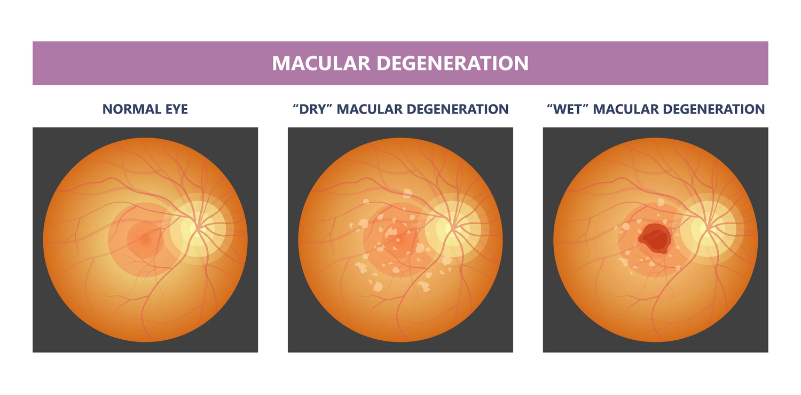What are the early signs of age-related macular degeneration?
As we age, our bodies go through a series of natural changes, and our eyes are no exception. One of the most common age-related conditions is age-related macular degeneration (AMD). Affecting adults over 50, AMD can lead to changes in vision that impact everyday life. The good news? With early detection and proactive care, you can protect your eye health for years to come.
We’ll guide you through the signs of age-related macular degeneration and the steps you can take to preserve your vision.
Understanding age-related macular degeneration

Age-related macular degeneration primarily affects the macula, the central portion of your retina. The macula is essential for processing fine details, whether you’re reading small text, recognizing faces, or driving. When the macula is damaged, it impacts your central vision, making these tasks challenging. However, peripheral (side) vision usually remains intact.
AMD is a progressive condition, meaning it can worsen over time. But don’t worry—identifying the early signs of age-related macular degeneration can make a difference. With proper care and planning, many individuals maintain their quality of life despite an AMD diagnosis.
There are two primary types of AMD: dry and wet, and understanding the differences between them is key to managing the condition effectively.
Dry AMD is the most common form, affecting approximately 90% of those with the condition. It occurs when the macula thins over time, leading to gradual vision changes. While there is no way to reverse dry AMD, adopting certain lifestyle changes and seeking early intervention can slow its progression.
Wet AMD is less common but progresses more rapidly. It happens when abnormal blood vessels form beneath the retina, leaking fluid or blood. This can lead to quick vision changes. Thankfully, with treatment of age-related macular degeneration such as injections, wet AMD can be effectively managed and its progression slowed.
What causes AMD?

There’s no single cause of AMD, but several factors increase your risk. Age, of course, is a primary one. Other contributors include smoking, poor diet, high blood pressure, and a family history of the condition.
By understanding these factors and taking proactive steps, you can better protect your eyes as you age.
Recognizing the signs of AMD

Early detection is key to managing AMD effectively. However, the early signs of age-related macular degeneration can sometimes be subtle. It’s important to pay attention to changes in your vision and stay proactive with routine care. Here’s what to look for:
Blurry or distorted vision: Objects in the center of your vision may appear blurry, and straight lines could look wavy or misaligned.
Difficulty with tasks requiring detailed vision: You may find it challenging to perform activities such as reading, sewing, or driving at night, as the central vision becomes more affected.
Dark or empty spots in your vision: Some individuals may notice blank spots in the center of their vision, making it hard to see objects clearly.
Typically, these symptoms develop gradually and may not be immediately noticeable. That’s why early detection through regular eye exams is essential for effectively managing AMD, preserving your vision, and preventing loss of sight long-term.
The role of regular eye exams

Regular eye exams are one of the most effective ways to detect age-related macular degeneration. At Kvitle Eye Care Associates, our comprehensive eye evaluations are designed to identify conditions like AMD early, often before symptoms become noticeable.
During your exam, Dr. Jason Kvitle uses advanced diagnostic tools and imaging technology to assess the health of your retina and macula carefully. These tests may include:
Retinal imaging: This method captures detailed images of the retina, allowing us to monitor any changes in its condition over time. It helps detect early signs of AMD before symptoms are noticeable.
Optical coherence tomography (OCT): OCT is a non-invasive imaging technique that provides high-resolution 3D cross-sectional images of the retinal layers. It helps identify even the tiniest abnormalities, such as thinning or changes in tissue thickness and can track the progression of AMD over time.
Visual Field Test: This test evaluates your peripheral vision, or the ability to see objects outside of your direct line of sight. It helps detect areas where vision may be affected, which can be an early sign of AMD.
Regular exams are the foundation of prevention and early intervention, helping you safeguard your eye health.
Treatment options and lifestyle changes

While no cure exists, effective options are available for managing AMD, particularly when diagnosed early. Dr. Kvitle is an accredited eye disease specialist and will create tailored strategies to match your individual needs, including both lifestyle guidance and medical treatment.
Dry Age-Related Macular Degeneration Treatment
For dry AMD, lifestyle changes and the use of specific supplements can slow its progression. Diets rich in antioxidants like vitamins C and E, zinc, and beta-carotene support eye health. Additionally, quitting smoking and managing conditions like high blood pressure play a significant role in protecting your vision.
Wet Age-Related Macular Degeneration Treatment
Treatment for wet AMD often involves anti-VEGF injections. These medications work by targeting abnormal blood vessel growth under the retina. Regular treatment helps maintain vision and prevent further damage to the macula.
Your care plan may also include recommendations for low vision aids or tools to support everyday activities if vision loss progresses, like glasses.
Stay on top of your eye health

Your vision deserves expert care and attention, especially as you age. Staying proactive through regular exams and adopting healthy habits can help you recognize the signs of age-related macular degeneration early and slow its progression.
If you’re over 50 or have a family history of AMD, now is the time to take action. Schedule an appointment with Dr. Jason Kvitle at Kvitle Eye Care Associates and enjoy peace of mind knowing your vision is in skilled, dedicated and experienced hands.
 1107 College Ave Quincy, IL 62301
1107 College Ave Quincy, IL 62301


